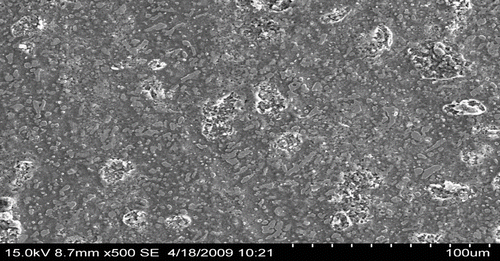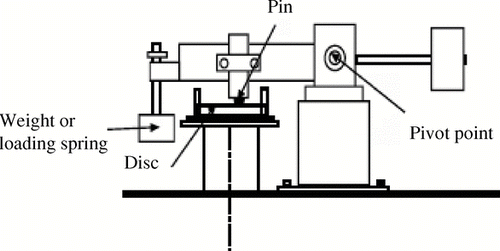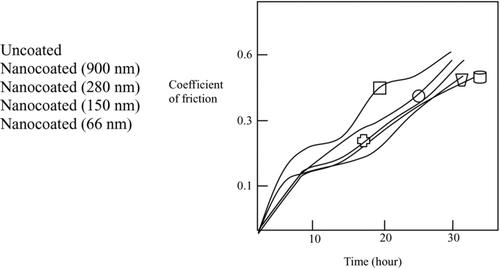ABSTRACT
Nano means small but of high potency, and emerging with large applications piercing through all the discipline of knowledge, leading to industrial and technological growth. In other words, nano-sized structure needs to be magnified over 10 million times before we can easily appreciate its fine detail with the naked eye. Nanotechnology is already having its impact on products as diverse as novel foods, medical devices, chemical coatings, personal health testing kits, sensors for security systems, water purification units for manned space craft, displays for hand-held computer games, and high-resolution cinema screens. Nanotechnology is expected to have an impact on nearly every industry. Nanotechnology can overcome the negative impact of wear and friction, enhance the life of the component, and improve the efficiency. The aim of this work is to reduce the size of chromium nitrate particles to the order of nano (10−9m) size using sol-gel method, analyze the surface topography of the steel and aluminium specimens by means of scanning electron microscopy (SEM), atomic force microscopy (AFM), and powder X-ray diffractometry (XRD) analyses after coating them using physical vapor deposition (PVD) process. Pin on disc apparatus is used to study the wear and friction behavior according to the sliding wear nature hip joint and bearing applications.
INTRODUCTION
Wear and friction in human life plays an important role and modern techniques has been developed to control the effect of wear, to enhance the life of component having relative motion, in the field of technology. Aluminium alloys has been showing a successful trend in replacing cast iron and copper alloys in various technological applications due to their superior mechanical and tribological properties and better castability. A390 aluminium alloy has been utilized in high-tech structural and functional applications, including bearings, aerospace, defense automotive and thermal management areas, as well as in sports and recreation.[ Citation 1 , Citation 2 , Citation 3 , Citation 4 ] The major advantages of this alloy over other alloys are its greater strength, good stiffness, reduced density, and good corrosion resistance. Aluminium is the material of choice in many applications, especially where weight and thermal conductivity are important.
Bearings applications are an important area in which there is a good need for new materials and new surface modification methods in order to have a better wear-resistant performance while in service. Metallic materials are highly appreciated due to their good wear resistance and high mechanical properties such as hardness and ductility, whereas polymers usually show low friction coefficients and excellent chemical stability.[ Citation 5 ] Aluminium alloys are popular for their reduced wear and good strength-to-weight ratio properties.[ Citation 6 ]
In nanotechnology, a particle is defined as a small object that behaves as a whole unit in terms of its transport and properties. It is further classified according to size: In terms of diameter, fine particles cover a range between 100 and 2500 nm, whereas ultrafine particles are sized between 1 and 100 nm. Similar to ultrafine particles, nanoparticles are sized between 1 and 100 nm, though the size limitation can be restricted to two dimensions. Nanoparticles may or may not exhibit size-related properties that differ significantly from those observed in fine particles or bulk materials.
Nanoparticles are of great scientific interest as they are effectively a bridge between bulk materials and atomic or molecular structures. A bulk material should have constant physical properties regardless of its size, but at the nano-scale this is often not the case. Size-dependent properties are observed such as quantum confinement in semiconductor particles, surface Plasmon resonance in some metal particles, and superparamagnetism in magnetic materials. Nanoparticles have a very high surface area–to-volume ratio. This provides a tremendous driving force for diffusion, especially at elevated temperatures. Sintering can take place at lower temperatures, over shorter time scales than for larger particles. This theoretically does not affect the density of the final product, though flow difficulties and the tendency of nanoparticles to agglomerate complicates matters. The large surface area–to-volume ratio also reduces the incipient melting temperature of nanoparticles.
Moreover, nanoparticles have been found to impart some extra properties to various day-to-day products. Like the presence of titanium dioxide nanoparticles impart what we call as the self-cleaning effect, and the size being nanorange, the particles can't be seen. Nano zinc oxide particles have been found to have superior ultraviolet (UV) blocking properties compared to its bulk substitute. This is one of the reasons why it is often used in the sunscreen lotions. Clay nanoparticles when incorporated into polymer matrices increase reinforcement, leading to stronger plastics, verified by a higher glass transition temperature and other mechanical property tests. These nanoparticles are hard, and impart their properties to the polymer (plastic). Nanoparticles have also been attached to textile fibers in order to create smart and functional clothing.
Nanoparticle characterization is necessary to establish understanding and control of nanoparticle synthesis and applications. Characterization is done by using a variety of different techniques, mainly drawn from materials science. Common techniques are scanning electron microscopy (SEM), atomic force microscopy (AFM), powder X-ray diffractometry (XRD), etc. There are various methods for the fabrication of nano particles. They are attrition, pyrolysis, and sol-gel technology. The sol-gel process is a wet-chemical technique (chemical solution deposition) widely used recently in the fields of materials science and ceramic engineering.[ Citation 7 ]
In this work, improvement in wear resistance of the selected material is aimed using a way in which two techniques are involved step by step. They are sol-gel technique for synthesis of nanoparticles and physical vapor deposition (PVD) technique for nanocoating. Thus, the materials are nanocoated with the selected nanoparticle using PVD technique[ Citation 8 ] in which these nanoparticles are synthesized initially using sol-gel technique. Two major analyses are therefore involved in this work, one being the analysis of effectiveness of sol-gel method in synthesizing Cr(NO3)3· 9H2O nanoparticles and the other being the analysis of PVD technique in getting a nanocoating on the substrate surface so that there is an improvement in the wear resistance. The material is A390 aluminium alloy. This material is chosen for the application of bearings. The wear analysis is done for this selected application on the basis of ASTM (American Society for Testing and Materials) standards in order to have a replica of actual working conditions. The wear analysis is done for Cr(NO3)3· 9H2O (chromium nitrate)–nanocoated A390 aluminium alloy for bearing application and this result is compared with that of the uncoated specimen for bearing application. Thus the effectiveness of sol-gel method in the synthesis of nanoparticles is analyzed by means of nanocoating materials and doing wear test for the application under consideration.
EXPERIMENTAL PROCEDURE
The effectiveness of nanocoating in improving the wear resistance of chosen material is analyzed in the following new way of combining sol-gel and PVD techniques. First of all, the materials are machined to the required size and shape, so as to represent the pin or disc in the wear test apparatus that is pin-on-disc machine. The coating material chromium nitrate (Cr(NO3)3· 9H2O) is prepared by sol-gel methodology as explained below and characterized by XRD or AFM analysis. The substrate materials are coated and wear test is done for the two different applications under consideration according to ASTM standards.
Materials
Materials of A390 aluminium alloy are prepared in the form of pin and hardened steel is used as disc material. Pin material corresponds to the size of 6-mm-diameter and 32-mm-length cylindrical rod. Disc material has the dimension of 10 mm thickness and 120 mm diameter.
Sol-Gel Methodology and Nanocoating
The sol-gel process is a versatile solution for making nanoparticles from ceramic and glass materials. In general, the sol-gel process involves the transition of a system from a liquid “sol” into a solid “gel” phase.[ Citation 9 ] Here the precursor is subjected to a series of hydrolysis and polymerization reaction using suitable reducing agents to form a colloidal suspension or a “sol.” The following steps are performed in arriving at the nano sized chromium nitrate particles.
Initially distilled water (say 100 mL) is mixed with chromium nitrate (say 40 g) and is stirred for 30 min in the magnetic stirrer. The magnetic stirrer provides complete solubility of the powder in the distilled water and thus provides a clear solution. Now 2 g of polyvinyl alcohol (PVA) is weighed. This PVA acts as a reducing agent in this sol-gel process for chromium nitrate. These 2 g of PVA is added to the clear solution of the distilled water + chromium nitrate. This mixture is stirred again in the magnetic stirrer for 30 min. The clear solution that is got in this way is heated in the hot oven for 200°C for 5 h. This heating converts the clear solution into powder form (green color for chromium nitrate). Now the powder is put in the alumina crucible (alumina crucible is preferred as it can withstand high temperatures). The powder in the alumina crucible is kept inside the muffle furnace and is heated up to 850°C for almost 7–8 h. This heating reduces the powdered form of the solution into nano size powder, the particle size analysis of which is done using AFM. The AFM image obtained for Cr(NO3)3· 9H2O nanoparticle is shown in .
Nanocoating
Physical vapor deposition (PVD) technique is used to coat the sol-gel–synthesized nano chromium nitrate powder on to the specimen substrates by evaporation method.[ Citation 10 ] The deposition chamber vacuum pressure is 10−4 torr, accelerating voltage at 20–25 kV and evaporation rate at 10−2 g/cm2· s.
Chromium nitrate coatings are of great importance because they are dense, continuous coating and can withstand elevated temperatures up to 700°C in air. It is highly inert—will not corrode and has excellent chemical resistance. It is nontoxic, can be used for medical surgical devices and food-processing equipment.
First, the A390 aluminium specimens are cleaned with acetone solution. This cleaning makes the surface free from dust, impurities, and finger impressions. The specimen is thus placed in the holder of the PVD machine and the chromium nitrate powder is placed in the wire-shape crucible placed between the electrodes. Now the primary pump is started to lower the pressure so as to create vacuum. After lowering the pressure for 1.5 h, evaporation of the powder starts automatically by passing electricity between the electrodes. This method of deposition of the powder onto the substrate is called “material evaporation method.” The specimen is coated for 30 min before it is taken out ().
Testing
Pin-on-disc apparatus used in this work is schematically shown in .
Nanocoated A390 aluminium pins are prepared as per standards of ASTM G77-93 (6 mm diameter, 32 mm length) and their wear and friction behavior is analyzed by comparing with the performance of uncoated A390 aluminium alloy specimens[ Citation 11 ] against hardened steel disc as disc material (120 mm diameter, 10 mm thickness).
Wear test using pin on disc apparatus is done on A390 aluminium alloy, both coated and uncoated, according to ASTM G77-93 standards for bearing applications.[ Citation 12 ] In the wear test for this material, the sliding speed is kept constant at 1 m/s according to ASTM G77-93 standards, load value is kept at 10 N, speed at 50 rpm, and output parameters such as wear volume in mm3 and coefficient of friction are noted down every 5 h for 30 h. Readings are given in and and graphs obtained are shown in and .
TABLE 1 Volumetric wear loss values for A390 aluminium alloy
TABLE 2 Coefficient of friction values for A390 aluminium alloy
RESULTS AND DISCUSSION
The results of XRD done on the nano-sized Cr(NO3)3· 9H2O particles synthesized in this work by sol-gel method before nanocoating on A390 aluminium material are summarized in and and .
TABLE 3 Measurement conditions of XRD shown in
TABLE 4 Peak list for XRD shown in
The wear test results of coated and uncoated A390 aluminium alloy material are given in and . From the graphs, the improvement in wear resistance of nanocoated specimens over the uncoated specimens is clear, as the volumetric wear loss is less for nanocoated specimens compared to uncoated specimen.
CONCLUSION
Chromium nitrate–nanocoated A390 aluminium material is suggested for bearing application. Sol-gel technology is a wet chemical method that provides a good means of synthesizing Cr(NO3)3· 9H2O chromium nitrate nanoparticles, using which the synthesized nanoparticles comes out to have various sizes of the order of 66, 150, 280, and 900 nm. AFM and XRD analysis are done for the so synthesized nanoparticle. XRD analysis is done using a measurement condition of 10.0250 start position [°2Th.] and 89.9750 end position [°2Th.] and peak list is calculated under different positions. Wear test results for A390 aluminium materials clearly show that the nanocoated specimens perform comparatively better than the respective uncoated specimens and the size of the nanoparticles synthesized by sol-gel method is directly proportional to the wear volume loss, that is, the smaller the size of particles synthesized by sol-gel method, the smaller is the wear volume loss.
REFERENCES
- Candan , S. and Bilgic , E. 2004 . Mater. Lett. , 58 : 2787 – 2790 .
- Szezepanik , S. and Sleboda , T. 1996 . Mater. Process. Technol. , 60 : 729 – 733 .
- Smith , W. and Hashemi , J. 2006 . Foundations of Material Science and Engineering, , 4th ed. , New York : McGraw-Hill International .
- Chaudhurky , S. K. , Singh , A. K. , Sivaramakrishnan , C. S. and Panigrahi , S. C. 2004 . Bull. Mater. Sci. , 27 : 517 – 521 .
- Wilches , L. V. and Uribe Toro , J. A. A. 2008 . Wear of materials used for artificial joints in total hip replacements . Wear , 265 : 143 – 149 .
- Turina , S. , Opalic , M. , Rakamaric , P. and Reka , A. 1989 . Mechanical-chemical wear process of an aluminium alloy bearing . Wear , 132 : 321 – 326 .
- Chidambaram , P. R. , Rangarajan , V. and Van Ooij , W. J. 1991 . Characterization of high temperature hot dip galvanized coatings . Surface Coatings Technol. , 46 : 245 – 253 .
- Bhav Singh , B. and Balasubramanian , M. 2009 . Processing and properties of copper coated carbon fibre reinforced aluminium alloy composites . J. Mater. Process. Technol. , 209 : 2104 – 2110 .
- Krzysztof Kwiatkowski , C. and Charles Lukehart , M. 2006 . Nanocomposites Prepared by Sol-Gel Methods: Synthesis and Characterization , Nashville , TN : Dept of Chemistry, Vanderbilt University .
- Gomez-del Rio , T. , Garrido , M. A. , Fernandez , J. E. , Cadenas , M. and Rodriguez , J. 2008 . Influence of the deposition techniques on the mechanical properties and microstructure of NiCrBSi coatings . J. Mater. Process. Technol. , 204 : 304 – 312 .
- Tam , P. L. , Zhou , Z. F. , Shum , P. W. and Li , K. Y. 2008 . Structural mechanical and tribological studies of Cr-Ti-Al-N coating with different chemical compositions . Thin Solid Films , 516 : 5725 – 5731 .
- Sadik Unlu , B. 2008 . “ Investigation of tribological and mechanical properties Al2O3-SiC reinforced Al composites manufactured by casting or P/M method ” . In Materials and Design , Vol. 29 , 2002 – 2008 . Amsterdam : Elsevier .
- Sannino , A. P. and Rack , H. J. 1995 . Dry sliding wear of discontinuously reinforced aluminium composites: review and discussion . Wear , 189 : 1 – 19 .





